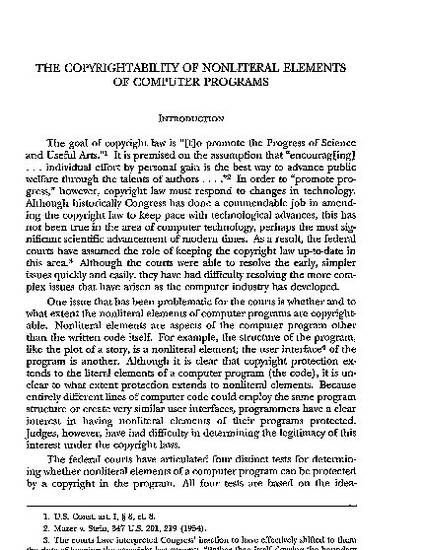
- Computer Law and
- Law
The goal of copyright law is "[t]o promote the Progress of Science and Useful Arts." It is premised on the assumption that "encourag[ing] . . . individual effort by personal gain is the best way to advance public welfare through the talents of authors . . ." In order to "promote progress," however, copyright law must respond to changes in technology.
One issue that has been problematic for the courts is whether and to what extent the nonliteral elements of computer programs are copyrightable. Nonliteral elements are aspects of the computer program other than the written code itself. Although it is clear that copyright protection extends to the literal elements of a computer program (the code), it is unclear to what extent protection extends to nonliteral elements.
The federal courts have articulated four distinct tests for determining whether nonliteral elements of a computer program can be protected by a copyright in the program. All four tests are based on the idea expression dichotomy that is the foundation for copyright law, yet they are all significantly different from each other. The debate over these tests has centered on whether a given approach "promotes progress" by providing an adequate level of copyright protection, or whether it stifles creativity by providing either too much or too little protection.
This Note argues that the Altai test, in modified form, is the best test for determining substantial similarity—and hence copyrightability—because it most closely adheres to general principles of copyright law. Such principles have served copyright law well in other areas and were intended by Congress to be applied to computer programs as well. Part I explains aspects of computer technology pertinent to this issue and provides a brief history of copyright law in the computer program context. Part II examines the Whelan, Paperback, Brown Bag, and Altai cases and provides a review of the criticism that has been leveled against each. Part III analyzes these tests, concludes that a modified version of the most sophisticated approach—the Altai test—would be best, and proposes an additional step for the analysis under that test. Finally, it reexamines some of the major concerns that are often raised against providing any protection to nonliteral elements of computer programs.
Available at: http://works.bepress.com/julian_velasco/7/

Reprinted with permission of the Columbia Law Review.